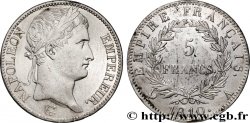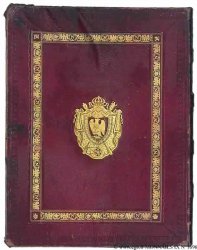v09_1696 - PREMIER EMPIRE / FIRST FRENCH EMPIRE Grand livre-médaillier (format 26x35 cm) en bois recouvert de cuir en mauvais état aux armes impériales, inscrit sur la tranche NAPOLEON/ MEDALS/ ANDRIEU et contenant deux plateaux de velours 24x32 cm épaisseur de 1 ce
MONNAIES 9 (2000)
Starting price : 609.80 €
Estimate : 1 219.59 €
Realised price : 609.80 €
Starting price : 609.80 €
Estimate : 1 219.59 €
Realised price : 609.80 €
Type : Grand livre-médaillier (format 26x35 cm) en bois recouvert de cuir en mauvais état aux armes impériales, inscrit sur la tranche NAPOLEON/ MEDALS/ ANDRIEU et contenant deux plateaux de velours 24x32 cm épaisseur de 1 centimètre avec deux médailles dans un plateau vert et huit médailles dans un plateau ocre
Date: n.d.
Engraver Bertrand Andrieu (1761-1822)
Rarity : R3
Obverse
Reverse
Commentary
Ensemble exceptionnel réalisé en Angleterre (à cause de la mention sur la tranche du livre-médaillier) et qui était destiné à une clientèle très fortunée. Toutes les médailles ont été gravées par B. Andrieu. Épaisseur 10 millimètres.
Toutes les médailles sont unifaces en étain bronzé et représentent des œuvres de B. Andrieu. Sur le premier plateau on voit : deux médailles de 140 mm représentant Napoléon Ier tête laurée à gauche et les bustes accolés de Napoléon Ier et de Marie-Louise. Sur le second plateau, on découvre huit médailles : deux de 85 mm représentant la prise de la Bastille le 14 juillet 1789 et le départ du roi, de la reine et du dauphin de Versailles pour Paris, le 6 octobre 1789. Les six autres médailles de 65 à 68 mm représentent : le passage du Grand Saint Bernard en 1800 et la bataille de Marengo le 14 juin 1800, deux portraits de Napoléon Ier, un portrait de Joséphine et l'autre de Marie-Louise.
Toutes les médailles sont unifaces en étain bronzé et représentent des œuvres de B. Andrieu. Sur le premier plateau on voit : deux médailles de 140 mm représentant Napoléon Ier tête laurée à gauche et les bustes accolés de Napoléon Ier et de Marie-Louise. Sur le second plateau, on découvre huit médailles : deux de 85 mm représentant la prise de la Bastille le 14 juillet 1789 et le départ du roi, de la reine et du dauphin de Versailles pour Paris, le 6 octobre 1789. Les six autres médailles de 65 à 68 mm représentent : le passage du Grand Saint Bernard en 1800 et la bataille de Marengo le 14 juin 1800, deux portraits de Napoléon Ier, un portrait de Joséphine et l'autre de Marie-Louise.








 Report a mistake
Report a mistake Print the page
Print the page Share my selection
Share my selection Ask a question
Ask a question Consign / sell
Consign / sell
 Full data
Full data










